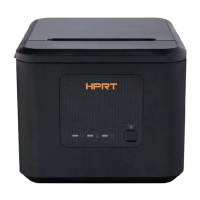This command is effective only when an autocutter error, a BM detecting error
or a platen-open error occurs.
The printer starts processing data upon receiving this command.
This command is executed even when the printer is offline, the receive buffer is
full, or there is an error status with a serial interface model.
With a parallel interface model, this command can not be executed when the
printer is busy. This command is executed even when the printer is offline or
there is an error status when Memory Switch 1-3 is on with a parallel interface
model.
The status is also transmitted whenever the data sequence of <10>H<05>H<n>
(1 ≤n ≤2) is received.
Example:
In ESC m nL nH dk, d1 = <10>H, d2 = <05>H, d3 = <01>H
This command should not be contained within another command that consists
of two or more bytes.
Example:
If you attempt to transmit ESC 3 n to the printer, but DTR (DSR for the host
computer) goes to MARK before n is transmitted, and DLE ENQ 2 interrupts
before n is received, the code <10>H for DLE ENQ 2 is processed as the code
for ESC 3 <10>H.
DLE ENQ 2 enables the printer to recover from an error after clearing the data
in the receive buffer and the print buffer. The printer retains the settings (by
ESC !, ESC 3, etc.) that were in effect when the error occurred. The printer can
be initialized completely by using this command and ESC @. This command is
enabled only for errors that have the possibility of recovery, except for print
head temperature error.

